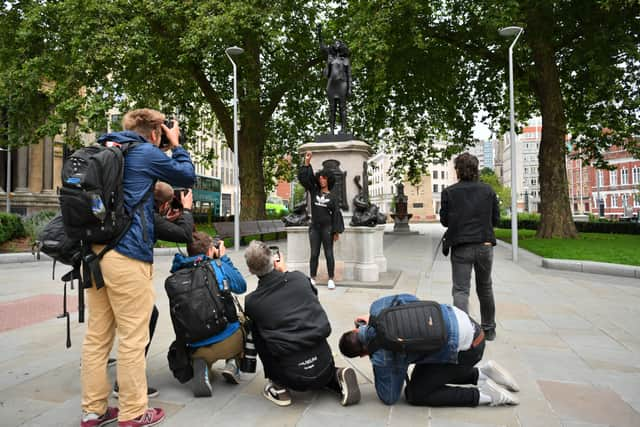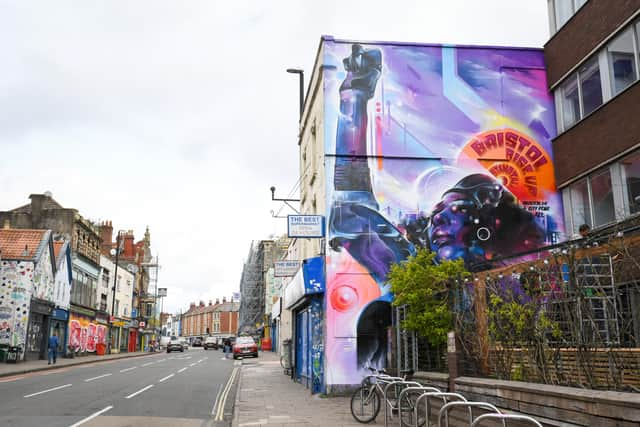‘I’m just a stand up girl’: Jen Reid on inspiring the youth, her statue and now ‘having a platform’
and live on Freeview channel 276
The phrase everyone gets their five minutes of fame is never more relevant than today.
With a myriad of talent shows on television an ordinary person can become a household name overnight.
But activism is increasingly propelling people into the spotlight too – from Greta Thunberg, to Just Stop Oil campaigners throwing soup over a Van Gough, to people tying themselves to football goalposts in the middle of Premier League match. All these acts have gone viral on social media and these faces have become well known.
Yet if you cast your mind back to the summer of 2020 our city of Bristol, was at the epicentre of the catalyst of something that went global. Something that hit the TV screens and social media across the planet. It was of course the toppling of the Colston Statue, which kick started a debate on the role of the city and the country’s role in the Trans Atlantic slave trade, and the role that venerating slave traders in statues plays. Similar statues started to go down all across the world.
But there was also a period of 24 hours in-between when something truly radical happened, that many may have forgotten, something that’s arguably been written out of the story. When black woman Jen Reid decided to stand up on the empty plinth and raise her fist in the air, in a black power salute, an artist took note.
A few days later a statue of Jen appeared on the plinth, placed by London artist Mark Quinn. The first statue of a black woman ever in the city of Bristol, a city that was founded on slave wealth. This soon hit the national media. Some people celebrated, some protested, and after a brief period of deliberation the city council removed it within a day. For many doing this so swiftly was a kick in the face to protest groups and campaigners, and Black Lives Matter itself, the same council who had failed to remove a statue of a slave trader for 125 years.


This caused a myriad of debates around why this happened, from threats of the far right to an invasion of space by a white artist coming into the city from the outside, to health and safety reasons to protect the public from it falling.
Quite quickly the story faded away. With countless documentaries on national radio and television, articles and features in national media, countless interviews, the story of Jen Reid became lost. Yet the image of a strong black woman on then plinth remains iconic and is still etched on some people’s minds. It’s been used in art exhibitions, huge graffiti placements in Bristol, and even as front poster to a Radio 4 series called Descendants.
So, in the latest series of interviews as part of the Legends of Bristol series, I paid a visit to see Jen, two years on to hear her side of the story. Why she was compelled to do it, if she feels her taking a stand has made any difference, how she felt about her statue coming down, and whether Bristol is coming to terms with its role in the slave trade in a more honest, open and transparent way.


Jen explains to me that it was on seeing the reaction from some young black women that congregated around her statue, that the impact hit home the most. She said: “All eyes were on the city, for the first time. And seeing those young black girls with their fists raised dressed as black panthers, and I was there for most of the day, and that was what really brought tears to my eyes.
“And the power, how empowered those girls felt,’ she added.
On realising she had always been an activist, and on activism itself Jen tells me: “I am who I was before that statue and after that statue. I will continue to say what I have to say, to I have to say it to. Whether that be working with a company with racists employees, whether that is to defend somebody else. The thing that has changed for me is that I now have a platform and a big mouth to do that.”
She also shares her frustration at the statue being removed.
Mayor Marvin Rees has spoken previously to say he was concerned about the ‘potential unintended consequences’ of the statue due to an increased risk of race hate incidents at the time. He spoke at length on the issue in response to a question at the Chamberlain Lecture in London in 2021, which can be viewed a video from 51 minutes by clicking here.
At the lecture, he said the keeping of the statue would create further tension and offer ‘confirmation’ to ‘those people’ who believed ‘they were losing their city’.
He added: “And there’s another dynamic around this, I’m the first black mayor. So what am I then known for? I’ve got to be additionally careful on this. The privilege of whiteness in that sense is to then move more critically of the old establishment - I have to be a bit more careful on those things before I pick up branding that undermines my ability to deliver on the more substantial issues that underpin race inequalities and class inequality in the city.”
And in a new statement to BristolWorld, a spokesperson for the Mayor’s Office said: “The Mayor has detailed at length why this statue, put up in Bristol without permission by a London artist, was removed.”
Watch the full interview above